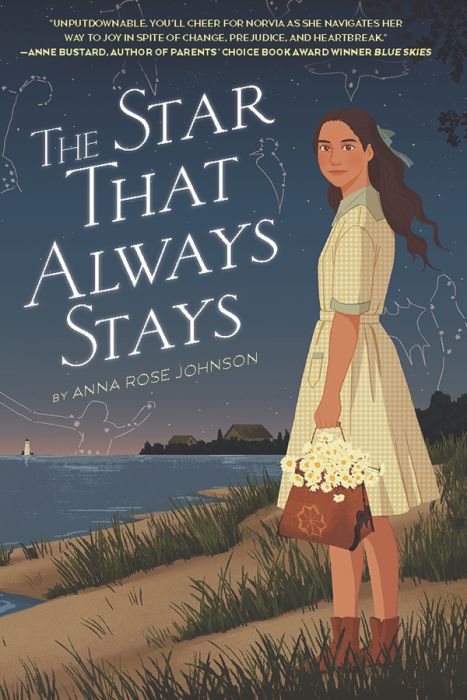
The Star That Always Stays
By Anna Rose Johnson
Edition
By Anna Rose Johnson
Hardcover edition
Publisher Holiday House Imprint Holiday House ISBN9780823450404
The Star That Always Stays
 20.9
20.9
In stock
SKU
9780823450404J
When bright and spirited Norvia moves from the country to the city, she has to live by one new rule: Never let anyone know you’re Ojibwe.
Growing up on Beaver Island, Grand-père told Norvia stories—stories about her ancestor Migizi, about Biboonke-o-nini the Wintermaker, about the Crane Clan and the Reindeer Clan. He sang her songs in the old language, and her grandmothers taught her to make story quilts and maple candy. On the island, Norvia was proud of her Ojibwe heritage.
Things are different in the city. Here, Norvia’s mother forces her to pretend she’s not Native at all—even to Mr. Ward, Ma’s new husband, and to Vernon, Norvia’s irritating new stepbrother. In fact, there are a lot of changes in the city: ten-cent movies, gleaming soda shops, speedy automobiles, ninth grade. It’s dizzying for a girl who grew up on the forested shores of Lake Michigan.
Despite the move, the upheaval, and the looming threat of world war, Norvia and her siblings—all five of them—are determined to make 1914 their best year ever. Norvia is certain that her future—both professionally and socially—depends upon it... and upon her discretion.
But how can she have the best year ever if she has to hide who she truly is?
Sensitive, enthralling, and classic in sensibility (perfect for Anne of Green Gables fans), this tender coming-of-age story about an introspective and brilliant Native American heroine thoughtfully addresses serious issues like assimilation, racism, and divorce, as well as everygirl problems like first crushes, making friends, fitting in, and the joys and pains of a blended family. Often funny, often heartbreaking, The Star That Always Stays is a fresh and vivid story directly inspired by Anna Rose Johnson’s family history.
Growing up on Beaver Island, Grand-père told Norvia stories—stories about her ancestor Migizi, about Biboonke-o-nini the Wintermaker, about the Crane Clan and the Reindeer Clan. He sang her songs in the old language, and her grandmothers taught her to make story quilts and maple candy. On the island, Norvia was proud of her Ojibwe heritage.
Things are different in the city. Here, Norvia’s mother forces her to pretend she’s not Native at all—even to Mr. Ward, Ma’s new husband, and to Vernon, Norvia’s irritating new stepbrother. In fact, there are a lot of changes in the city: ten-cent movies, gleaming soda shops, speedy automobiles, ninth grade. It’s dizzying for a girl who grew up on the forested shores of Lake Michigan.
Despite the move, the upheaval, and the looming threat of world war, Norvia and her siblings—all five of them—are determined to make 1914 their best year ever. Norvia is certain that her future—both professionally and socially—depends upon it... and upon her discretion.
But how can she have the best year ever if she has to hide who she truly is?
Sensitive, enthralling, and classic in sensibility (perfect for Anne of Green Gables fans), this tender coming-of-age story about an introspective and brilliant Native American heroine thoughtfully addresses serious issues like assimilation, racism, and divorce, as well as everygirl problems like first crushes, making friends, fitting in, and the joys and pains of a blended family. Often funny, often heartbreaking, The Star That Always Stays is a fresh and vivid story directly inspired by Anna Rose Johnson’s family history.
Family tree. Author’s note. Glossary and pronunciation guides. Family photographs.
|
Standard MARC Records Cover Art |
Advanced Readers Plus (Grades 6-8)
Advanced Readers Plus
Advanced Readers Plus (Grades 6-8)
For Grades 6-8
This collection expands reading opportunities with 14 additional titles each year, featuring compelling narratives that challenge and inspire. With a mix of humor, realism, and deeper themes, these selections cater to high-interest, reluctant, and struggling readers alike.
14 books per Year
$284.62 per Year
Interests
Fiction, High Interest/Reluctant Reader, Struggling Readers, Novels, Funny/Humorous, Realistic Fiction


